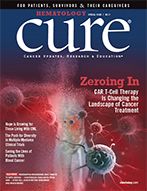Publication
Article
CURE
Weighing the Benefits and Risks of CAR T-Cell Therapy: The Stakes Are High
Author(s):
WITH EVERY POTENTIAL NEW treatment for cancer, there are known and unknown risks. The balance of these have to be determined for all medical decisions, and that is best accomplished by an informed and shared decision between the patients, their medical team and any other input that is helpful. There are few situations where the stakes are higher than in the use of the sophisticated new approaches involving engineered T cells to treat refractory hematologic malignancies with no curative options.
For years, oncologists have been treating patients with cancer with surgery, chemotherapy and radiation therapy. These have been the “pillars” of cancer treatment. Now, immunotherapy, the so-called fifth pillar, is picking up steam and excitement along the way.
One area of immunotherapy that is showing great promise in early trials is chimeric antigen receptor T-cell therapy or CAR T-cell therapy. Still being studied and refined by researchers, this process involves “engineering,” or genetically modifying, a patient’s own immune T cells to specifically recognize and attack cancer cells. Some groundbreaking studies have shown durable complete remissions in patients with therapy-refractory lymphoma and leukemia, which otherwise would be rapidly fatal.
These results have prompted the Food and Drug Administration to grant it breakthrough status for B-cell malignancies like acute lymphoblastic leukemia, chronic lymphocytic leukemia, as well as in B-cell lymphoma and non-Hodgkin lymphoma.
However, there are still many obstacles to overcome. In particular, with side effects which can sometimes be fatal. There are major toxicities involved with CAR T-cell treatment. The hyperactive T cells can spiral so out of control, like an immunologic wrecking ball inside the body, that very sudden side effects can occur related to autoimmune effects. These may include unexpected organ damage, neurologic toxicities like speech impairment, seizures, hallucinations and facial nerve palsy. Some trials have even been shut down due to patient deaths.
In this special issue of CURE®, we hear the story of one little girl who experienced a “cytokine storm”— caused by CAR T-cells — so severe, that she was put into an induced coma for two weeks.
This situation occurs when the immune cell activation results in the release of too many cytokines, which can result in labored breathing, rapid pulse, high fevers and decreased blood flow to internal organs. She survived that “storm” and has now been cancer-free for five years. This may be due, in part, to her team being prepared. Some institutions have specialized teams to handle CAR T-cell therapy side effects, such as the “cytokine storm” team that is on call at MD Anderson and has unique expertise and special biologic drugs to reverse these effects. But, at this time, this kind of team isn’t usually found at the community hospital level.
These serious toxicities speak to the need for careful deliberation for each case, support systems in place and, importantly, a dedication to ongoing research to perfect both the effectiveness and management of side effects of this exciting type of immunotherapy.
DEBU TRIPATHY, M.D.
Editor-in-Chief Professor of Medicine Chair, Department of Breast Medical Oncology The University of Texas MD Anderson Cancer Center






